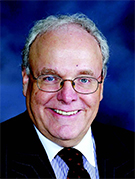Quality of the Peer Reviewer Impacts Quality of Journal
Radiology and RadioGraphics journals rely heavily on peer review in maintaining the high quality of published studies


The quality of manuscripts published in a scientific journal relies heavily on peer review for assessing the strengths and limitations of the material and providing a nonjudgmental, objective critique of the submission, according to RSNA journal editors.
"We rely on the expertise of the reviewers to identify the best science and to help improve the quality of the work," said Radiology Editor, Herbert Y. Kressel, M.D. "The quality of a peer-reviewed scientific journal like Radiology is a direct reflection of the quality of the peer reviewers."
Dr. Kressel and Jeffrey S. Klein, M.D., editor of RadioGraphics, discussed peer review for their respective publications during the RSNA Publications Council-sponsored session, "Reviewing Manuscripts for the RSNA Journals," at RSNA 2015. Radiology has a research focus, while RadioGraphics has an educational focus.
Both doctors gave insights on the important roles served by peer reviewers and the types of information they should consider when given manuscripts. Peer reviewers are asked for their input as experts in the subspecialty and on the specific topic of the submission. A peer reviewer makes suggestions to the editor and author on methods to improve the paper.
"These comments provide a rationale for rendering decisions on the paper," said Dr. Klein, the A. Bradley Soule and John P. Tampas Green and Gold Professor of Radiology, University of Vermont College of Medicine. "Reviewers also indicate whether the paper covers materials recently published in RadioGraphics or other imaging journals, as ideally we would like our papers to add to our readers' existing fund of knowledge and practice."
Most of the material for RadioGraphics comes from RSNA annual meeting education exhibits, Dr. Klein said. Reviewers are typically experienced clinicians and have reviewed for the journal for many years. Many of the publication's reviewers are also authors and understand the important components of a highquality submission, he said.
"Given their expertise and knowledge of the quality of submission we typically publish, the reviewers' assessment is the most important component of maintaining the high quality of our published material," Dr. Klein said.
Annually, Radiology receives nearly 3,000 submissions and publishes 360 to 380 manuscripts, Dr. Kressel said. Its active reviewer pool consists of approximately 1,000 experts from around the world. Submissions are pre-screened by one of the editors before peer review for suitability. In addition to scientific peer review, accepted research submissions undergo a separate statistical review.
Dr. Kressel asks reviewers to evaluate the quality of the science and the educational value of a manuscript, as well as the validity of its claims and conclusions.
"We ask Radiology reviewers to summarize the study, identify strengths and weaknesses as well as specific comments to improve the quality of the manuscript," Dr. Kressel said. "We also ask them to make sure that the criticism is constructive in nature and not harsh or insulting."
RadioGraphics reviews about 220 manuscripts annually, Dr. Klein said. The journal publishes about 180 educational papers annually and has approximately 750 reviewers; many review for both journals, he said.
Both journals can earn the reviewer credit. Radiology reviewers can request CME for their reviews at the time they are submitted. If the quality of the review is satisfactory the reviewer can receive three hours of AMA PRA Category 1 CME Credit™ for a reviewed manuscript, Dr. Kressel said. RadioGraphics offers three hours of AMA PRA Category 1 CME Credit™ for a review of adequate quality as assessed by the editor.

Web Extras
- For more information on becoming a reviewer for Radiology or RadioGraphics, go to RSNA.org/Journals